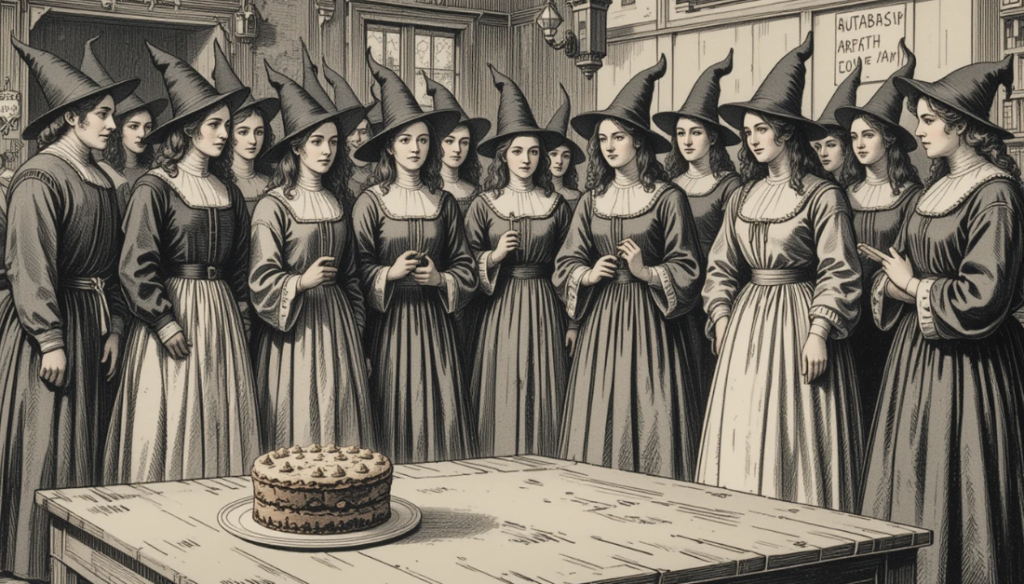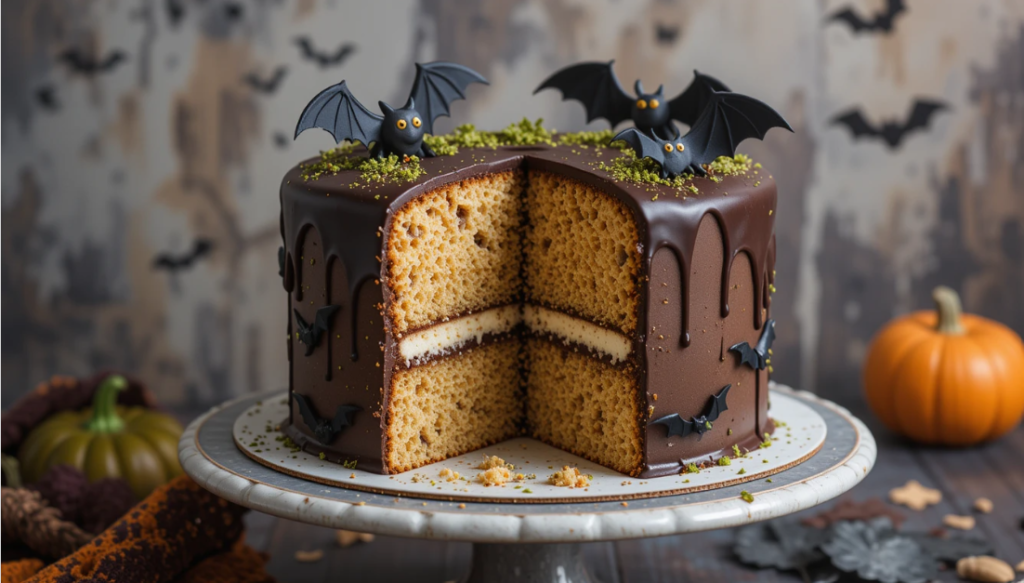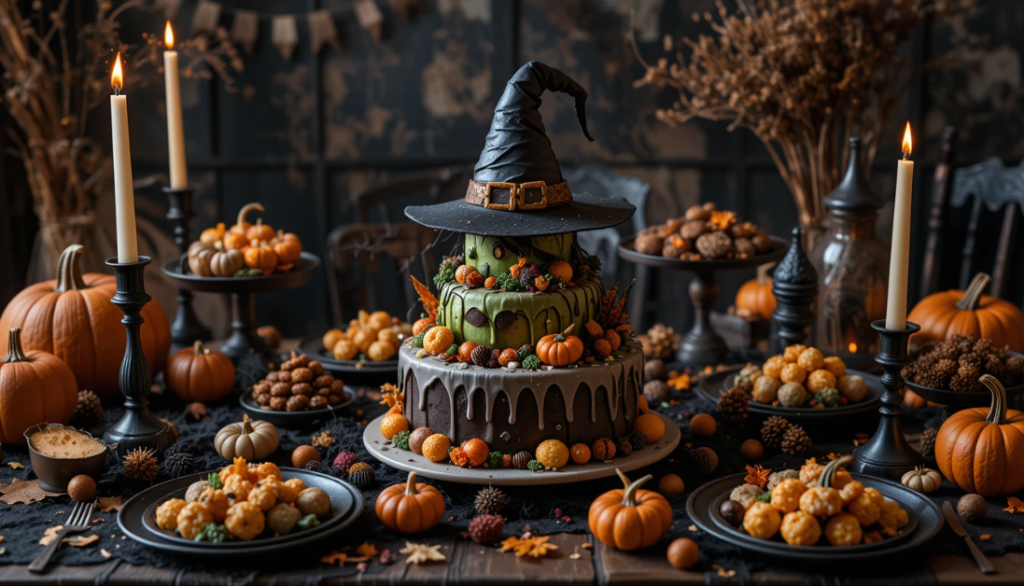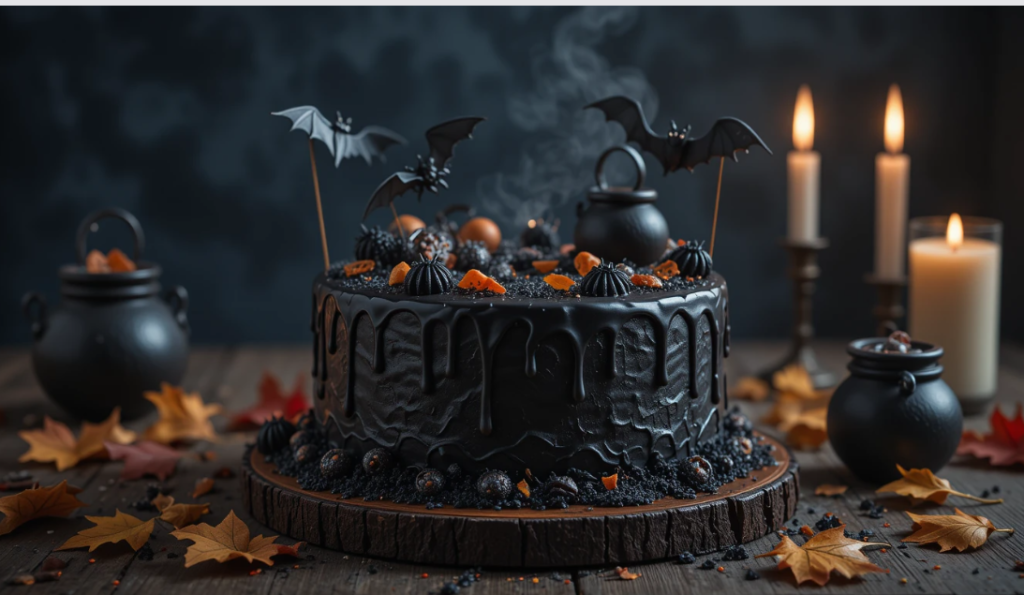Have you ever heard of a dessert that’s more than just a sweet treat? Something that carries a mysterious, almost magical aura? Well, let me introduce you to the Witches Cake! 🧁✨ This isn’t your typical birthday cake or a fancy pastry you’d find at a bakery. No, the Witches Cake is steeped in history, folklore, and a touch of the supernatural. But what exactly is it? Where did it come from? And why does it continue to fascinate people today? Buckle up, because we’re about to take a deliciously dark journey into the world of the Witches Cake.
Table of Contents
The Origins

Let’s start at the beginning. The Witches Cake isn’t a modern invention—it’s been around for centuries. Its roots can be traced back to the Salem Witch Trials in the late 1600s. Back then, people believed in witchcraft and often accused women of being witches. One of the methods used to “prove” someone was a witch involved a peculiar cake.
“The Witches Cake was made with rye meal and the urine of the accused. It was then fed to a dog, believed to reveal the witch’s identity through the dog’s behavior.”
Yes, you read that right. It sounds bizarre now, but back then, it was taken very seriously. The cake was thought to have magical properties, and its creation was tied to superstition and fear.
The Role of the Witches Cake in History
The Witches Cake wasn’t just a random recipe—it played a significant role in one of the darkest chapters of American history. During the Salem Witch Trials, fear and paranoia ran rampant. People were desperate to find “proof” of witchcraft, and the Witches Cake became a tool for that.
Imagine living in a time where something as simple as a cake could determine whether someone lived or died. It’s chilling, isn’t it? The Witches Cake is a reminder of how fear and ignorance can lead to tragic consequences.
What is a Witches Cake Made Of?
Traditional Ingredients
The original recipe was pretty grim. Here’s what it typically included:
- Rye meal: A coarse flour made from rye grains.
- Urine: Yes, this was a key ingredient, believed to carry the “essence” of the accused.
- Water or milk: To bind the ingredients together.
Sounds unappetizing, right? Thankfully, modern versions of the Witches Cake have ditched the urine and focused on creating something you’d actually want to eat.
Modern Interpretations
Today, this Cake is more about celebrating its spooky history than recreating its original recipe. Modern bakers have come up with creative twists, using ingredients like:
- Chocolate: Because what’s a cake without chocolate?
- Spices: Cinnamon, nutmeg, and cloves to give it a warm, autumnal flavor.
- Decorative elements: Think black frosting, edible glitter, and fondant shapes like bats or cauldrons.
Here’s a quick table comparing the traditional and modern ingredients:
| Ingredient | Traditional Witches Cake | Modern Witches Cake |
|---|---|---|
| Flour | Rye meal | All-purpose flour |
| Liquid | Urine | Milk or water |
| Flavoring | None | Chocolate, spices |
| Decoration | None | Black frosting, glitter |
The Cultural Significance
The Witches Cake in Folklore and Mythology
In folklore, the Witches Cake is often associated with magic and mystery. It’s said that witches used similar cakes in their rituals, though the historical accuracy of this is debatable. Still, the idea of a “magical cake” has captured the imagination of storytellers for generations.
The Witches Cake in Popular Culture
From books to movies, the Witches Cake has made its way into popular culture. It’s often depicted as a spooky, Halloween-themed treat, perfect for parties and witchy gatherings. Shows like Chilling Adventures of Sabrina and movies like Hocus Pocus have helped keep the legend alive.
Common Misconceptions
Is the Witches Cake Associated with Evil?
Not necessarily. While its origins are tied to the Salem Witch Trials, the modern Witches Cake is more about fun and creativity than anything sinister. It’s a way to celebrate Halloween and embrace the spooky side of life.
Debunking Myths
One common myth is that the Witches Cake was always used for evil purposes. In reality, it was more about superstition and fear than actual witchcraft. Another myth is that it’s inedible. While the traditional version certainly wasn’t appetizing, modern versions are delicious!
How to Make a Witches Cake: A Step-by-Step Guide

Gathering the Ingredients
For a modern Witches Cake, you’ll need:
- 2 cups all-purpose flour
- 1 cup sugar
- 1/2 cup cocoa powder
- 1 tsp baking soda
- 1/2 tsp salt
- 1 cup milk
- 1/2 cup vegetable oil
- 1 tsp vanilla extract
- 1 tbsp vinegar
Preparing the Cake
Preheat your oven to 350°F (175°C).
Mix the dry ingredients in a large bowl.
Add the wet ingredients and stir until smooth.
Pour the batter into a greased cake pan.
Bake for 30-35 minutes, or until a toothpick comes out clean.
Baking and Decorating Tips
Use black food coloring to give the frosting a spooky look.
Add edible glitter for a magical touch.
Top with fondant shapes like bats, spiders, or cauldrons.
The Most Common Problems When Making the Cake
Problem 1: Finding Authentic Ingredients
If you’re trying to recreate the traditional Witches Cake, you might struggle to find rye meal. Solution? Use all-purpose flour instead—it’s much easier to work with!
Problem 2: Achieving the Right Texture
A dry cake is a sad cake. To avoid this, make sure not to overmix the batter and keep an eye on the baking time.
Problem 3: Balancing Flavors
Too much spice can overpower the cake. Start with small amounts and adjust to taste.
Solutions to Common Witches Cake Problems
Let’s face it—baking can be tricky, especially when you’re dealing with a cake as unique as the Witches Cake. But don’t worry, I’ve got your back! Here are some solutions to the most common problems you might encounter.
Solution 1: Substituting Hard-to-Find Ingredients
If you’re trying to stay true to the traditional recipe but can’t find rye meal, don’t stress. All-purpose flour works just fine and is much easier to find. For a more rustic texture, you can mix in a bit of whole wheat flour. And, of course, skip the urine—modern bakers definitely don’t recommend that! 😅
Solution 2: Perfecting the Baking Process
Baking is both an art and a science. To ensure your Witches Cake turns out moist and fluffy:
- Don’t overmix the batter: Overmixing can lead to a dense, tough cake. Mix until just combined.
- Check your oven temperature: An oven thermometer can help you avoid under- or over-baking.
- Use the toothpick test: Insert a toothpick into the center of the cake. If it comes out clean, your cake is done!
Solution 3: Experimenting with Flavors
The beauty of the modern Witches Cake is that you can get creative with flavors. Love chocolate? Add cocoa powder. Prefer something spicier? Throw in some cinnamon, nutmeg, or even a pinch of cayenne for a kick. The possibilities are endless!
Tips for Making the Perfect Witches Cake
Want to take your Cake to the next level? Here are some tips to make it truly magical.
Tip 1: Research the History
Understanding the history of this Cake can inspire your baking. Plus, it makes for a great story to share with your friends or family while enjoying the cake.
Tip 2: Use High-Quality Ingredients
The better your ingredients, the better your cake will taste. Splurge on good-quality cocoa powder, fresh spices, and real vanilla extract.
Tip 3: Pay Attention to Presentation
A Witches Cake should look as enchanting as it tastes. Use black and purple frosting, edible glitter, and spooky decorations like fondant bats or sugar spiders.
The Witches Cake in Modern Witchcraft
The Witches Cake isn’t just a historical curiosity—it’s also found a place in modern witchcraft. Let’s explore how today’s witches use this mysterious dessert.
How Modern Witches Use the Witches Cake
In contemporary witchcraft, the Witches Cake is often used in rituals and celebrations. It’s seen as a way to honor the past while embracing the present. Some witches use it as an offering during Samhain (a pagan festival that inspired Halloween), while others bake it as a symbol of protection or prosperity.
The Witches Cake in Rituals and Celebrations
During rituals, the Witches Cake might be placed on an altar or shared among participants. It’s not just food—it’s a symbol of community, magic, and connection to the spiritual world.
The Witches Cake and Its Connection to Halloween

Speaking of celebrations, the Witches Cake has become a staple of Halloween festivities. Let’s dive into why this spooky dessert is perfect for the season.
Why the Witches Cake is a Halloween Staple
Halloween is all about embracing the mysterious and macabre, and the Witches Cake fits right in. Its dark history and magical associations make it the perfect treat for a night of tricks and treats. Plus, it’s a great way to add a touch of witchy flair to your Halloween party.
Halloween-Themed Witches Cake Ideas
Want to make your Witches Cake extra festive? Try these ideas:
- Pumpkin Spice Witches Cake: Add pumpkin puree and pumpkin spice to the batter for a seasonal twist.
- Candy Toppings: Use Halloween candies like gummy worms, candy corn, or chocolate bats as decorations.
- Glow-in-the-Dark Frosting: Use edible glow powder to make your cake shine in the dark.
Frequently Asked Questions
Let’s tackle some of the most common questions people have about the Witches Cake.
What Does the Witches Cake Symbolize?
The Witches Cake symbolizes a blend of history, mystery, and magic. It’s a reminder of the past while also being a fun, creative way to celebrate the present.
Can Anyone Make a this Cake?
Absolutely! You don’t have to be a witch or a master baker to make it. All you need is a little creativity and a willingness to embrace the spooky side of life.
Is the Witches Cake Safe to Eat?
Modern versions of the Witches Cake are perfectly safe to eat. Just stick to edible ingredients, and you’ll be fine.
Conclusion:
The Witches Cake is more than just a dessert—it’s a piece of history, a symbol of magic, and a delicious way to celebrate the spooky season. Whether you’re baking it for Halloween, a witchy ritual, or just because, the Witches Cake is sure to cast a spell on everyone who tries it.
Why this Cake Continues to Fascinate
From its dark origins to its modern reinvention, the Witches Cake has a unique ability to captivate people. It’s a reminder of how food can be more than just sustenance—it can be a story, a tradition, and a way to connect with others.
Final Thoughts
So, the next time you’re in the mood for something sweet and a little spooky, why not try making a Witches Cake? Whether you stick to the traditional recipe or put your own spin on it, you’re sure to create something magical.
If you are someone who likes to perfect his recipes this article is for you: https://tastymakings.com/the-best-flour-for-homemade-crackers/
Nutrition Facts Table
| Nutrient | Amount per Serving |
|---|---|
| Calories | 300 |
| Total Fat | 12g |
| Saturated Fat | 3g |
| Cholesterol | 20mg |
| Sodium | 200mg |
| Total Carbohydrates | 45g |
| Dietary Fiber | 2g |
| Sugars | 30g |
| Protein | 4g |
Ingredients and Quantities Table
| Ingredient | Quantity |
|---|---|
| All-purpose flour | 2 cups |
| Sugar | 1 cup |
| Cocoa powder | 1/2 cup |
| Baking soda | 1 tsp |
| Salt | 1/2 tsp |
| Milk | 1 cup |
| Vegetable oil | 1/2 cup |
| Vanilla extract | 1 tsp |
| Vinegar | 1 tbsp |

